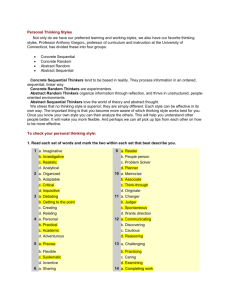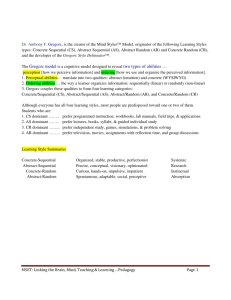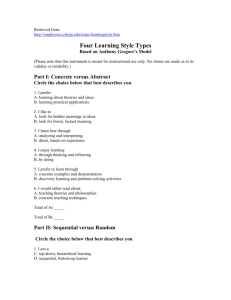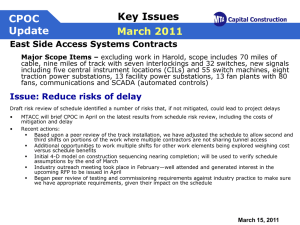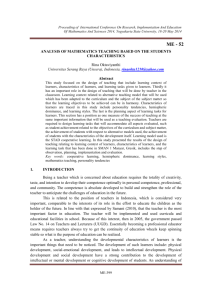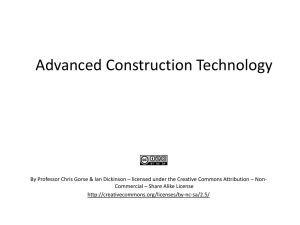Empowering Learners with Learning Styles Steve Barkley 2013
advertisement
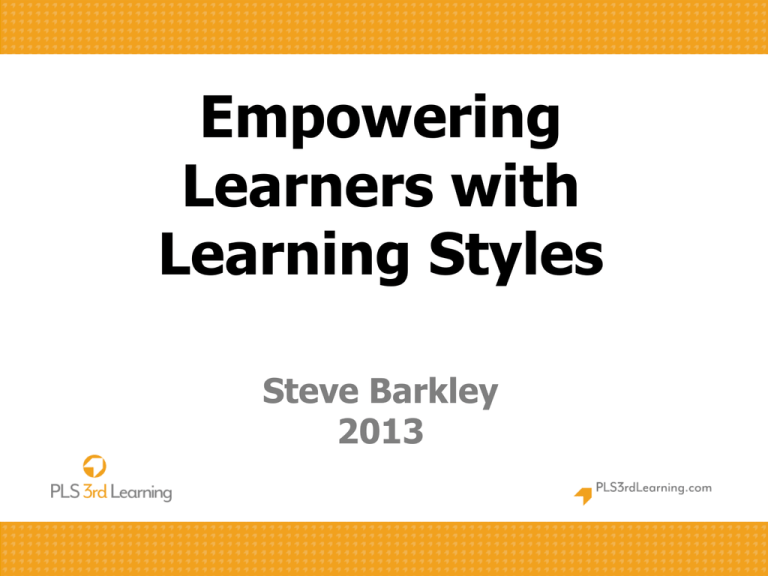
Empowering Learners with Learning Styles Steve Barkley 2013 Gordon’s Skill Development Ladder The Art of Teaching Unconsciously Talented Unconsciously Unskilled Consciously Unskilled Unconsciously Skilled Consciously Skilled Gordon’s (1974) Skill Development Ladder 3 Rotate and Empower • Rotate instructional practices creating opportunities for students to work within their preferred style. • Empower students to use knowledge about their preferences in making choices and investing effort. Quick-Pick Interpretation of The Kaleidoscope Profile® Results SENSORY STYLES Kinesthetic: Tactual: Visual: Auditory: Works best when able to move and do things with large muscles. Works best when able to see, watch, read, and view. Works best when able to hear, speak, discuss, and think out loud. Works best when able to feel through small muscles and personal relationships. Sharing Style Experiences • What are the strengths of your style? • What difficulties arise from your style? • Share some personal stories that illustrate. Auditory Plus One The previous activity was an example of auditory plus tactual. What components are tactual? Auditory Plus Visual Graphic organizers are an example. Which ones fit in your instruction? Auditory Plus Kinesthetic Building in movement Model of the Earth Rocks, Trees, Water Moving Plates Oozy, Asthenosphere Crust Lithosphere Asthenosphere Hot Rocks Deep Mantle Molten Magma Outer Core Tough Stuff Inner Core Quick-Pick Interpretation of The Kaleidoscope Profile® Results PERCEPTUAL AND ORGANIZATIONAL STYLES Concrete: Abstract: Global: Sequential: Prefers to work with real objects, sounds, colors, and experiences. Prefers to work with symbols, words, numbers, and other abstractions. Prefers to work with the “big picture,” large chunks, and intuitive leaps. Prefers to work with step-by-step, orderly, logical information. GASC Diagram Right Hemisphere Left Hemisphere Synthesis Stories Inductive Reasoning Analysis Classification Deductive Reasoning Global Concrete /Images Visuals Sounds Feelings Body Movements Sequential Abstract /Symbols Written Words Spoken Words Numerals Equations The information on this diagram is set up as though you are facing someone. AS CS Abstract Sequential Concrete Sequential discuss, read compute numbers sequentially and analyze verbally do things in their head part-by-part procedures step-by-step directions real world things Concrete Global CG trial/error real world in random discovery method of learning Continuum Organizational Perceptual Abstract Global discuss ideas, concepts, pattern, associations play with words create metaphors AG GASC — Teaching Strategies Concrete/Sequential Abstract/Sequential • field trips organized step-by-step, • lectures, with questions and answers with a goal • structured, hands-on materials such as models • structured demonstration lessons • simulations that follow the rules • using step-by-step directions to complete a task • using concrete materials and following directions in a step-by step progression • audiotapes and/or videotapes in a step-by-step sequence • almost all textbooks • presenting logical thought and constructions • explaining theories through deductive reasoning • programmed instruction ____________________________________ ___________________________________ ____________________________________ ____________________________________ GASC — Teaching Strategies Concrete/Global Abstract/Global • optional assignments involving real • open-ended think sessions • group discussions • allowing think time for reflections things • problem solving simulations • open-ended, discovery-type field trips • learning through trial and error and seeing real objects • committee work on real projects • discovery learning ________________________ before beginning a project or assignment • allowing students to make intuitive leaps • using the synthesis process to allow students to get an “Aha!” • optional reading assignments ___________________________________ _________________________________ ___________________________________ __________________________________ Quick-Pick Interpretation of The Kaleidoscope Profile® Results TEMPERAMENT STYLES Intuitive Feeler: Intuitive Thinker: Sensing Judger: Sensing Perceiver: Values integrity, relationships and personal and emotional issues. Values competence, rational reasoning, and intellectual complexities. Values authority, organization, predictability, and usefulness. Values action, excitement, style, competition, and immediate responses. Differentiate for the At-Risk Learner • Kinesthetic • Concrete Global • Sensing Perceiver Live Event Learning
